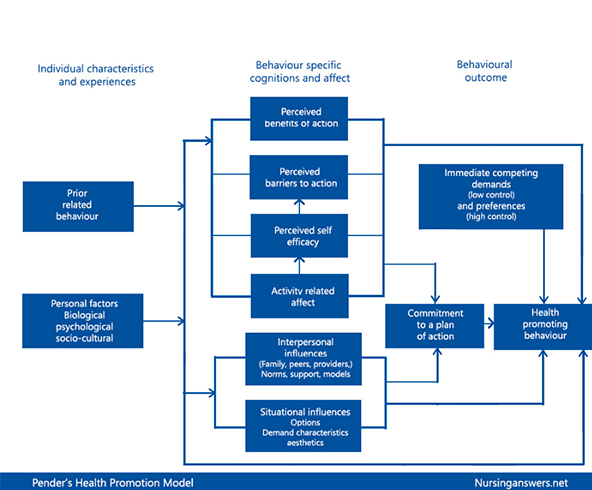Introduction
The health promotion model was developed in 1982 by Dr. Nola J. Pender. Pender believed that the goal of nursing care was to help patients achieve optimal health and well-being. The model was created following Pender’s work examining health promoting and preventative behaviours. The health promotion model claims that each individual’s characteristics and life experiences have a direct impact on their actions and decisions regarding their health. Health is not defined solely as the absence of disease but the state of well-being. Pender’s health promotion model has been revised since its first creation and has had significant influence on the work of other theorists.
What are the concepts of the health promotion model?
Pender’s health promotion model concentrates on three major categories: individual characteristics and experiences, behaviour-specific cognitions and affect and lastly, the behavioural outcomes.
1. Individual Characteristics and Experiences
The first category explores the concept that each individual has his or her own set of characteristics and experiences, which in turn help shape their actions. Pender emphasised that one’s past actions have a direct link to whether they would partake in future health-promoting behaviours. Personal attributes and habits can also be a barrier to health-promoting behaviours.
2. Behaviour-specific Cognitions
The second category involves the behaviour-specific cognitions and affect which have a direct impact on the individual’s motivation for change. Nursing interventions can be tailored to these variables to assist in forming positive changes. Variables include; the observed benefits and barriers to the action, self-worth, and the activity-related result.
3. Behavioural Outcomes
The third category is the behavioural outcome. The start of the outcome begins with the person committing to taking the steps necessary to make a change. During this phase the individual must be supported with barriers addressed in order to produce a positive health-promoting behaviour. The goal of the health promotion model is to stimulate a behavioural change that results in a positive health outcome.

Concepts in Pender's Health Promotion Model
Major concepts in Pender’s health promotion model include; the person, their environment, health, and nursing. The person is the central focus of the model. The person’s experiences and attributes have a direct impact on future actions and decisions. One must assess the learned behaviours we gain from our family and community environments. These learned behaviours influence the individual’s ability to participate in health-promoting behaviours. The environment includes the person’s physical, social, and economic conditions. A healthy environment is free of toxins, has economic stability, and allows access to resources that promote healthy living. How one defines health has a direct impact on the promotion of well-being and prevention of disease. Through motivation the individual is able to prevent illness and promote healthy behaviours. In order to foster positive health-promoting behaviours the nurse must take into account the individual’s self-worth, benefits for the change, environmental control, and any potential barriers to change.
The Health Promotion Model makes four assumptions:
- Individuals seek to actively regulate their own behaviour.
- Individuals, in all their biopsychosocial complexity, interact with the environment, progressively transforming the environment as well as being transformed over time.
- Health professionals, such as nurses, constitute a part of the interpersonal environment, which exerts influence on people through their life span.
- Self-initiated reconfiguration of the person-environment interactive patterns is essential to changing behaviour.
There are thirteen theoretical statements that come from the model. They provide a basis for investigative work on health behaviours. The statements are:
- Prior behaviour and inherited and acquired characteristics influence beliefs, affect, and enactment of health-promoting behaviour.
- Persons commit to engaging in behaviours from which they anticipate deriving personally valued benefits.
- Perceived barriers can constrain commitment to action, a mediator of behaviour as well as actual behaviour.
- Perceived competence or self-efficacy to execute a given behaviour increases the likelihood of commitment to action and actual performance of the behaviour.
- Greater perceived self-efficacy results in fewer perceived barriers to a specific health behaviour.
- Positive affect toward a behaviour results in greater perceived self-efficacy, which can in turn, result in increased positive affect.
- When positive emotions or affect are associated with a behaviour, the probability of commitment and action is increased.
- Persons are more likely to commit to and engage in health-promoting behaviours when significant others model the behaviour, expect the behaviour to occur, and provide assistance and support to enable the behaviour.
- Families, peers, and health care providers are important sources of interpersonal influence that can increase or decrease commitment to and engagement in health-promoting behaviour.
- Situational influences in the external environment can increase or decrease commitment to or participation in health-promoting behaviour.
- The greater the commitments to a specific plan of action, the more likely health-promoting behaviours are to be maintained over time.
- Commitment to a plan of action is less likely to result in the desired behaviour when competing demands over which persons have little control require immediate attention.
- Persons can modify cognitions, affect, and the interpersonal and physical environment to create incentives for health actions.
Evaluation
The simplicity of the health promotion model enables it to be easily adapted in the community health setting. We have a chance to improve a patient’s well-being and prevent disease when health-promoting behaviours are established in the community environment. Due to its ease of use, the health promotion model is a valuable tool in the field of nursing research. The use of Pender’s Health Promotion Model can positively affect and improve health behaviours. Pender’s health promotion model drives the nurse to tailor their education to meet the individual and environmental needs of their patient in order to initiate a health-promoting behavioural change.
Cite This Work
To export a reference to this article please select a referencing style below:

